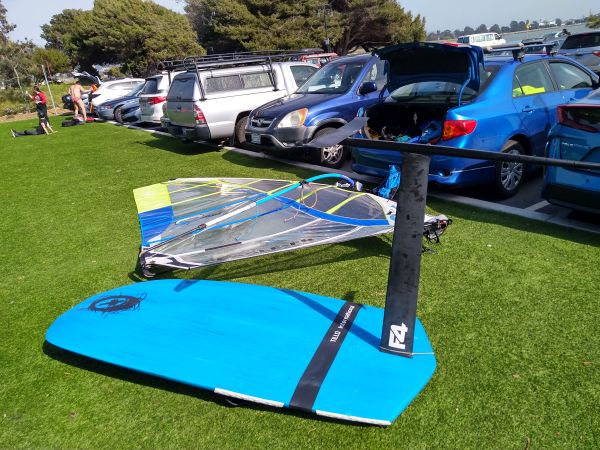Windsurf Foiling

What is foiling? This is the practice and art of adding an underwater wing to a water craft which under appropriate conditions will raise the bulk of the water craft out of the water thus reducing drag and increasing speed.

Yes foiling literally gets you high 🐳. Foils have been applied to watercraft as diverse as Americas cup yachts 🐋 to kite surfers 🦈. Our club, however, is non-exclusively concerned with foiling windsurfers 🐬.
Why?
In an ideal world the wind would blow at the time and speed desired and we could all sail nice small and agile boards like the one shown in Figure 3.
However in most of the real world we have to make do with non-ideal wind conditions, in particular lighter and more variable than desired. To deal with the lighter side of the wind bigger sails and wider boards were used. This reached its zenith with formula windsurf boards that can be about a meter wide and utilize sail sizes up to 12 square meters. The large sails required much strength to deal with and could be quite a problem if the wind decided to increase significantly. The wider boards while quick to get on a plane would bounce around a lot if the conditions got choppy (oh my aching knees!).
Foiling solves both these aforementioned problems. Up on a foil a windsurfer has much less drag requiring significantly smaller sails sizes for similar conditions. While we can still use wide floaty boards to get us started we don't bounce around in the chop since we are up on the foil. Note this is for typical use as large chop presents a challenge to foilers too! Hence we end up with a type of windsurfing that is suitable and comfortable for a wider range of conditions!
Headquarters Berkeley
The headquarters for the Bay Area Windsurf Foiling Club (BAWFC) is the Berkeley Marina and more particularly the south sailing basin. Why you might ask? See below for information regarding our location, safety considerations and proper launching and dock use procedures. More questions just ask a member, any foiler you see, or email Greg B.
The Whole Bay is Our Playground
From Berkeley a huge chunk of San Francisco bay is accessible via windsurfer under the appropriate conditions including: Treasure Island, Angel Island, Alcatraz, the San Francisco city front, and even the Golden Gate Bridge. Where you can go to is highly dependent on your skill level and bay conditions. You should not do long distance windsurfing alone, or go beyond your limits. Here at BAWFC we prefer to be rescuers rather than rescuees!

That Wind Thing...
Berkeley is not usually the windiest spot on the bay. However from Berkeley you can sail to some of the windiest spots on the bay such as Treasure Island and Angel Island. In addition Berkeley is sailable under a relatively wide range of wind directions from south west to north west and a bit more.
A Relatively Safe Place to Learn
Located on the East Bay shoreline, the predominantly westerly winds tend to blow you back towards shore. Care needs to be taken when sailing outside the "basin" since currents in the Bay can be significant! This is a particular concern for long distance sailing if the wind dies. So check the currents if taking a long distance sail (Treasure Island or beyond) under light wind conditions.
Proper Dock Etiquette
The other advantage of Berkeley as the headquarters for BAWFC is the small craft docks available in the south sailing basin. Foils need deeper water and dock launching is easier on equipment and bodies. See below for proper launch and docking techniques.
The docks in the south sailing basin are relatively small and are used by many different users including conventional windsurfers, wing foilers, kayakers, open ocean swimmers, etc... Windsurf sails and foiling boards take up significant space. This also applies to wing foil gear! Do not leave equipment on the docks or tied to the docks for extended periods as this blocks others from coming in and out!
For launching boards are carried to the docks first, then sails, then you go. When done take your sail off the dock first, then come back quickly and take your board out of the way. Yes, I know your tired and have great stories to tell everyone, but move your board!
Avoid the Mud! 💩
As a foiler you can't ignore the tides! Hitting submerged objects at high speed is extremely hazardous to your health and equipment. Getting stuck in the mud and having to drag your equipment through it is also extremely unpleasant and exhausting. Always check the tides.
We provide two calendars that show days and times where the tides are above a 2.7 foot minimum or a 3.0 foot minimum. Note that this information is provided for informational purposes only with no guarantees of accuracy, see the NOAA Tide Predictions for Berkeley for accurate data. Also wind an other conditions can influence tide levels. Use good judgement, if the tide is looking low when you're coming back in maybe get off the foil early and take it slow as you get closer to the docks.